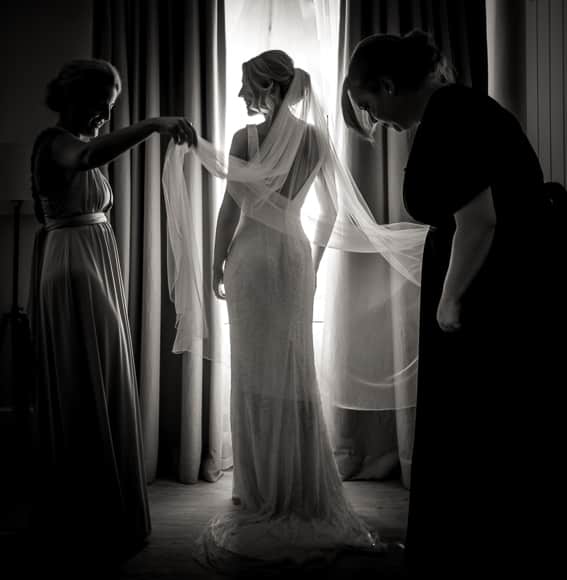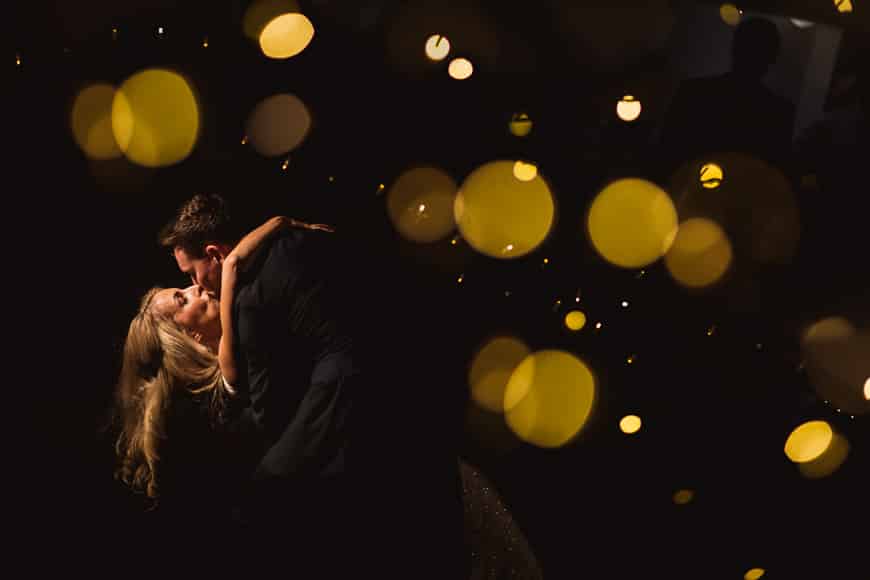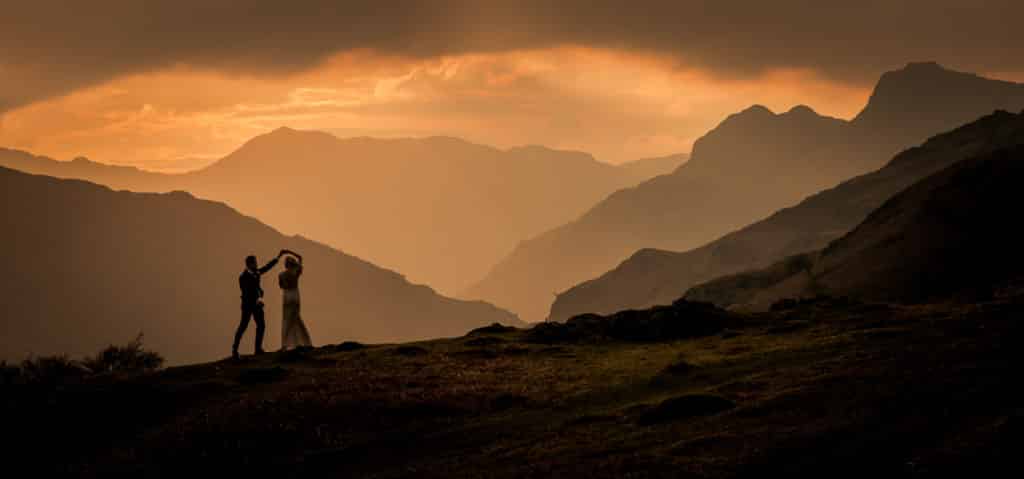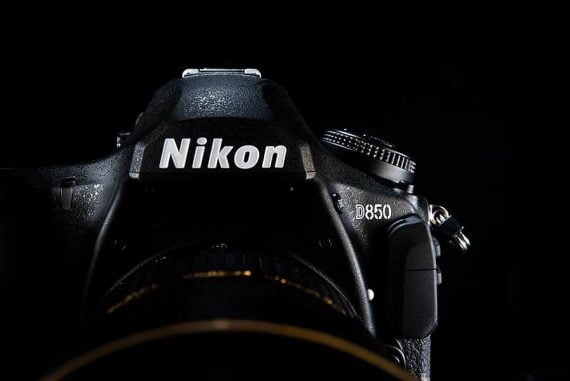









Robin Goodlad
Wedding | Last Updated: February 12, 2021
I’m Robin Goodlad, a wedding photographer based in Dorset, England.
I’ve been shooting weddings professionally for 15 years or so, though I shot my first wedding back in 1994.
That’s relevant perhaps in how I have seen the genre evolve from the days of shooting on film. If you consider how often you pressed the shutter back then, and that you delivered perhaps 30-40 images from the wedding, it’s a huge contrast to the many thousand I shoot at the fast-paced weddings of today.
My style and equipment has, of course, evolved significantly since then, but there are certain values in how I document a day which have remained a constant.
I like to observe and document with quietness and respect as much as possible, and over time I have simply added the things I felt I needed to be able to do this job much better, whether lighting or other equipment.
I see my work as primarily documentary, with sprinkles of creativity thrown in where I need to make a shot.
I don’t want to be in the position of missing a shot because I don’t have the right lens with me, or the right light, so I carry everything I think I need in my shoulder bag, and it’s an approach which just feels right. I never feel like I am lugging too much around with me, and if I see some amazing light, I need to know I have everything with me for that shot – otherwise the light and the moment might be gone.
I’ve always used Nikon, since I was 15. I don’t even remember why, perhaps it was the romanticism of being a teenager getting misty-eyed with the classic lines and style of the F4, or maybe it was just the red stripe… who knows.
I’ve tested Canons and Fujis over the years, and just didn’t get on with them personally.
I know a lot of my peers have jumped ship to the Sony system and they wax lyrical about the benefits, but perhaps they have never used a D850, which is Nikon’s best yet.
It might not have eye AF, but I’m not going to change a whole system on a whim, especially if Nikon bring out something even better soon. I wouldn’t say it was based on brand loyalty, it is more about knowing your camera inside out so you can operate it without thinking.
It’s a tool at the end of the day, and one you have to be comfortable with. The D850 feels comfortable in my hand, all day long, whereas I find the Fuji or Sony just doesn’t feel comfortable for me, and ergonomics are important.
My kit
I use two Nikon D850s, which are labelled as left and right, and these are how I wear them every day, either on the Holdfast Moneymaker harness or the SpiderPro belt.
Weight distribution is really important to maintain comfort on long days, and the Moneymaker is brilliant, and in beautiful leather too (I do love beautifully crafted things!).
I then also wear a modified SpiderPro belt; the belt and pads I made myself and they are much lower profile than the original, so can’t be seen under my waistcoat.
When I shoot the evening, I tend to use just one camera, so I will then park it on the SpiderPro belt. This gives me flexibility during the day too; if I need to unclip a camera from the Holdfast for an overhead shot, I can then quickly park it on the belt.
Another advantage of this for me is that the spider attachment on the camera gives me two tripod mount threads – one for the Holdfast eyelet, and the other so I can quickly screw in my monopod for overhead shots, which I do a lot. It’s a way of working that is really adaptable through the day.
My D850 bodies are labelled left and right so I am always using a combination of a longer focal length on the left and shorter on the right.
Usually this is the Nikon 85mm f/1.8 on the left, and the Nikon 35mm f/1.4 on the right; or it might be other combinations of Nikon 105mm f/2.8 micro or Nikon 70-200mm f/2.8 on the left, and 24mm f/1.8 or 17-35mm f/2.8 on the right.
The point is that I am always able to swap between long and wide: whichever combination I use based on the space I am shooting in, I always know which side to go for.
The other lenses are in my bag. Distinguishing between left and right also allows me to run slightly different settings, the minimum shutter speed is set lower on the right to allow the lowest ISO possible, whereas it has to be higher on the left based on the reciprocal rule.
This might sound like a lot of glass to be carrying, but it feels fine for me, and when I want to go really wide, or long, or shoot macro details, I have everything I need, rather than making do.
Bag
My ONA Union Street bag is amazing, I spent years looking for the perfect bag, and this one in canvas just gets better with age.
I have enough space for my monopod, all my lenses, a spare slot for changing lenses – and taking out one divider I can slot in a D850 if need be.
Swing it round to the front to access lenses, and then out of the way behind, and I hardly notice it is there. If it starts to rain, I just fold over the flap, and things stay dry.
A key piece of kit is my Manfrotto compact mini pod which I use lots for overhead shots and which is small enough to fit in my bag.
I use Interval Timer mode a lot for getting shots from above (I am quite short!) and also for group shots where I need to get the camera up high quickly.
My bag also contains my shoot notes, spare batteries, spare memory cards, lens cloths, and a few bits of glass and copper tube for creative shots, a grey card for tricky white balance and, importantly, a soda stream bottle for fresh fizzy water and a few snacks too – I love Cliff bars as the most realistic tasting high energy pick me up which won’t melt in the heat.
I can slot a folded Lastolite reflector in the laptop slot as well.
My bag is never complete without a few ball bungees, perfect for securing light stands at venues to stop guests knocking them over, and anything else which needs holding down.
I also carry a small pair of scissors and a few cable ties which weigh nothing. Why? I find a lot at weddings that things need trimming or fixing, and if you can help, it all adds to the service.
Lighting
One piece of kit which is also always in my bag, along with a Manfrotto Pixi tripod, is the Dedolight LEDzilla. I discovered this light last year, and it is incredible.
It packs down to the same size as a lens, but gives an impressive light which can be turned into a flood light or spot. It has barn doors too, and two easily folding colour modifiers so it is really easy to direct the light exactly how you want it.
It is perfect for spotlighting cakes, details or couples when you don’t want or need the power of flash – I wouldn’t be without it!
A huge plus with the LEDzilla is that with the adaptor, it runs off my Nikon D850 batteries, so I just rotate the spares throughout the day and have another always on charge in the van. Simple!
I also have a Westcott Ice Light which I use quite a bit, and I fix it to the top of my bag with a couple of ball bungees, if I need it, though I don’t take it with me all the time (unlike the LEDzilla).
In the evening, and more so for speeches these days, I will use two or three off-camera flashes – a combination of Nikon SB700 and Godox V350N (for the advantage of the lithium battery, and over time I will make more of a change) on Manfrotto Nano stands.
These are triggered by Cactus V6 triggers. For my flash work, I want to be able to control each flash independently, and I only use the simple features of the flash, which is why I prefer the SB700 over the SB900.
For speeches and dancing, I use the custom modes in the D850 so I can quickly switch between manual for flash work, and ambient for documentary work simultaneously.
I then use the Magmod system to add gels and grids to control the light even more for that perfect look.
Spares and accessories
In the van I also have a Manfrotto roller with a Nikon D750, a couple of “nifty fifties” (Nikon 50mm f/1.4), a 24mm f/1.8 and 85mm f/1.8, and a lot of spare batteries, memory cards, a bank of chargers, as well as umbrellas, a spare shirt, and spare shoes and socks for rainy days.
The van itself has been a real game-changer for me. It’s a converted VW with fridge, cooker, and of course a rock and roll bed, perfect for getting on-site at a wedding and having breakfast, a cup of strong espresso here and there, and of course a bed to lie on for staying over after late weddings.
It might sound like a luxury, but it really helps me to reset my creative head through the day, and know I can always eat and drink wherever I am. I wouldn’t be without it!
www.robingoodlad.com | @robingoodladphotography

Check out these 8 essential tools to help you succeed as a professional photographer.
Includes limited-time discounts.












